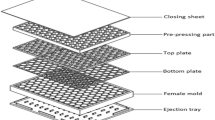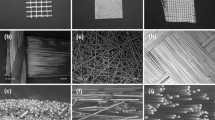Abstract
Building owners are increasingly interested in a healthy and sustainable living environment, which is a trend favoring ecological building materials with outstanding structural physical parameters. Insulation boards from particles of larch bark (Larix decidua Mill.) bonded with a formaldehyde-free tannin resin were pressed and evaluated for their mechanical and physical properties. It could be shown that light (target density 250 kg/m3) boards can be pressed, and their thermal conductivity is low (0.065–0.09 W/(m*K)). With regard to mechanical characteristics, the influence of panel density was studied, and it was found that a certain compaction (ρ ≥ 400 kg/m3) is necessary to meet the requirements of the relevant standard. Interestingly, the resin amount did not influence the mechanical board properties as strongly as expected, and panel density is the most important variable in this respect. The study proved that tree bark cannot only be used for substantially upgraded insulation panels but can also be bonded with a formaldehyde free tannin resin.









Similar content being viewed by others
References
Barbu MC (2011) Current developments in the forestry and wood industry. ProLigno 7(4):11–124
EN 12667 (2001) Determination of the thermal resistance with the panel and heat flow panel measuring device (in German). European Committee for Standardization (CEN), Brussels
EN 310 (1993a) Engineered wood products: Determination of the modulus of rupture and the modulus of elasticity. European Committee for Standardization (CEN), Brussels (In German)
EN 317 (1993b) Fiberboards and particleboards: Determination of the thickness swelling after water storage. European Committee for Standardization (CEN), Brussels (In German)
EN 319 (1993c) Fiberboards and particleboards: Determination of the internal bond. European Committee for Standardization (CEN), Brussels (In German)
EN 326-1 (1994) Engineered wood products: Sampling, blanking and supervision, part 1: Sampling and cutting of specimens and analysis of results. European Committee for Standardization (CEN), Brussels (In German)
EN 622-4 (2010) Fiberboards requirements: Requirements for porous panels. European Committee for Standardization (CEN), Brussels (In German)
Fengel D, Wegener G (2003) Wood—chemistry, ultrastructure, reactions. Kessel, Remagen
Garnier S, Huang Z, Pizzi A (2001) Dry I.B. forecasting of commercial tannin adhesives-bonded particleboard by TMA bending. Eur J Wood Prod 59:46
Gupta G, Yan N, Feng MW (2011) Effects of pressing temperature and particle size on bark board properties made from beetle infested lodgepole pine (Pinus contorta) barks. For Prod J 61(6):478–488
Kain G, Teischinger A, Musso M, Barbu MC, Petutschnigg A (2012) Thermal insulation materials out of tree barks. Holztechnologie 53(4):31–37 (in German)
Kain G, Barbu MC, Teischinger A, Musso M, Petutschnigg A (2013a) Substantial bark use as insulation material. For Prod J 62(6):480–487
Kain G, Barbu MC, Hinterreiter S, Richter K, Petutschnigg A (2013b) Using bark as a heat insulation material. Bioresource 8(3):3718–3731
Kleinhempel A K (2005) Innovative insulation materials in civil engineering—current state of research and market compendium. Department for Energy, University of Bremen (in German)
Kraft R (2007) Chemical-technical utilization of used engineered wood products and tree bark. Dissertation, University of Göttingen (in German)
Mansouri HR, Navarrete P, Pizzi A, Tapin-Lingua S, Benjelloun-Mlayah B, Pasch H, Rigolet S (2011) Synthetic-resin-free wood panel adhesives from mixed low molecular mass lignin and tannin. Eur J Wood Prod 69:221–229
Martin RE (1963) Thermal properties of bark. For Prod J 13(10):419–426
Moubarik A, Charrier B, Allal A, Charrier F, Pizzi A (2010) Development and optimization of a new formaldehyde-free cornstarch and tannin wood adhesive. Eur J Wood Prod 68:167–177
Pena C, Caba K, Retegi A, Ocando C, Labidi J, Echeverria JM, Mondragon I (2009) Mimosa and chestnut tannin extracts reacted with hexamine in solution http://link.springer.com/article/10.1007/s00107-009-0357-6. Journal of Therm. Anal. and Calorim. 96(2):515-521
Pfundstein M, Gellert R, Spitzner MH, Rudolphi A (2007) Insulation materials: basics, materials, applications. Department for International Architecture Documentation Corporation, Munich (in German)
Pichelin F, Kamoun C, Pizzi A (1999) Hexamine hardener behaviour: effects on wood glueing, tannin and other wood adhesives. Eur J Wood Prod 57:305–317
Pichelin F, Nakatani M, Pizzi A, Wieland S, Despres A, Rigolet S (2006) Thick wood panels bonded industrially with formaldehyde free tannin adhesives. For Prod J 56(5):31–36
Pizzi A (1982) Pine tannin adhesives for particleboard. Wood Sci Technol 40:293–301
Pizzi A (1994) Advanced wood adhesive technology. Dekker, New York
Pizzi A, Strecke P, Trosa A (1997) Industrial tannin/hexamine low-emission exterior particleboards. Eur J Wood Prod 55(2–4):168
Schwemmer R (2010) Development of a manufacturing technology for an insulation material out of reed mace. Federal Ministry for Association, Innovation and Technology, Vienna (in German)
Sellers T, Miller GD (2004) Laboratory manufacture of high moisture southern pine strandboard bonded with three tannin adhesive types. For Prod J 54(12):296–301
Thoemen H (2010) From wood to material—basic studies on production and structure of wood based materials. Bern University of Applied Sciences, Biel (in German)
Tondi G, Wieland S, Wimmer T, Schnabel T, Petutschnigg A (2012) Starch-sugar synergy in wood adhesion science: basic studies and particleboard production. Eur J Wood Prod 70(1–3):271–278
Xing C, Deng J, Zhang S Y, Riedl B and Cloutier A (2006) Impact of bark content on the properties of medium density fibreboard (MDF) in four species grown in eastern Canada http://link.springer.com/article/10.1007/s00107-011-0553-z. For Prod J 56(3):64–69
Acknowledgments
The authors are grateful for the support of the company Graggaber (sawmill Unternberg, Austria).
Author information
Authors and Affiliations
Corresponding author
Rights and permissions
About this article
Cite this article
Kain, G., Güttler, V., Barbu, MC. et al. Density related properties of bark insulation boards bonded with tannin hexamine resin. Eur. J. Wood Prod. 72, 417–424 (2014). https://doi.org/10.1007/s00107-014-0798-4
Received:
Published:
Issue Date:
DOI: https://doi.org/10.1007/s00107-014-0798-4




